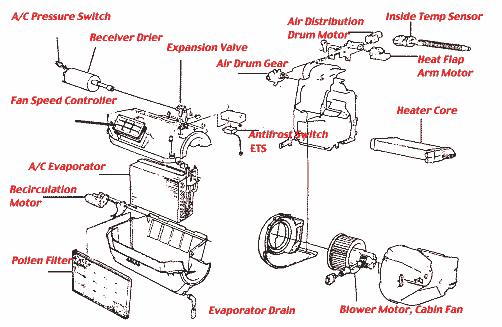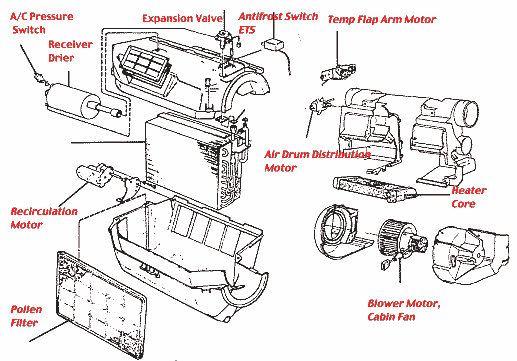
ACC I
9000 Heater
Core Replacement
90 and up 9000s have
a lower intake and are easier to replace the heater core in than the
early models. On the pre 90 cars, you have to make space to remove
the fan box by at least removing the dashpot on the throttle (if
equipped) and possibly the cam that the accelerator cable attaches
to. Some find it easier to remove the intake by loosening the runner
hose clamps. You can do the job without removing the wipers and the
intake, but you have to be careful and patient to maneuver the boxes
out of the aquarium past the wipers and the intake. For the most
space, remove the wiper transmission/motor and the intake. Getting
the wiper transmission out takes about as long as the heater core. To
do it, remove the wiper arms, noting that they are marked L and R on
their under surface. Remove the nuts holding the arms to the pivot
shafts, Hinge the arms up, away from the windshield and work them off
the shafts' splines. Then remove the rubber covers over the pivots
and remove the nuts on the pivots. Remove the three covers under the
hood at the aquarium( the space above the engine compartment below
the windshield. Remove the clips holding the plastic molding under
the windshield, the big rubber plug in it and carefully remove it
from the car. Then undo the wiring to the wiper motor, and remove the
4 10 mm bolts holding it to the car. Carefully extract the assembly.
if you remove the intake, be careful of the rubber connectors on the
runners. They are a task to get back on and to make seal properly.
The intake also has a support bracket on each end of it. Be careful
of the oil dipstick tube. It is plastic and can easily break if it is
brittle. 86 models do not have a split intake and will require a bit
more work if you elect to remove the intake as well as the purchase
of an intake manifold gasket. Again, if careful, patient and
resourceful, you can do the job without removing the intake. Follow
the later procedure after this point.

ACC I
Discharge the A/C. You might want to have a shop recover the Freon, the best thing for safety and the environment. You will have to disconnect the refrigerant lines to the evaporator to do the job. Refrigerant can suffocate you in an enclosed area and frostbite exposed flesh.
Remove the covers for the aquarium, the space under the windshield in the engine compartment. These are pretty straight forward. Remove the seal running along the width of the car in front of the covers and pull it up. Then remove the metal insert running along the aquarium by removing the bolt on it on the right side and one screw on the left. It fits into a channel and may take a little persuading to get it up. It will just pull up and out after the screws are removed. Note how the hoses and wiring are run through it and retain all of the insulating pieces around them or wear problems will occur as the wires and hose rub the metal later.
Drain the coolant. I recommend you thoroughly flush the system so none of the contaminates that dissolved the old heater core are still in there. I would replace the thermostat with a factory 82 degree one at this time as well. Use a hose and flush the system until clear water runs out every where you look, the hoses to the heater core, the thermostat housing and the radiator. We recommend Mercedes Benz coolant to eliminate any chance of recurrence when I got done with the repair. At $10 a gal, from a Benz dealer, it is less expensive than any cooling system repair. It is silicate and phosphate free and is specially buffered to resist any pH swings. Since switching to it 10 years ago, cooling system repairs in our shop have dropped dramatically. Mercedes formulated it to end problems they had with aluminum parts, heads , heater cores, water pumps etc. Antifreeze is definitely not all the same. See the cooling system page for more details on bulletproofing your cooling system.
Undo the two lines running up the right fender well to the AC. Undo them only at the evaporator, one at the receiver drier and one at the expansion valve. Make sure you use a wrench to hold both parts of the line connection. Just turning the nut part may damage the expansion valve or evaporator core. Try to find something to cover the ends of the lines to keep moisture out while the system is open, especially on the receiver drier. Plastic bags and rubber bands work ok. I also recommend you have the system recharged to prevent the deterioration of the system and future problems. That evaporator core costs twice what the heater core does. There is a white plastic collar that holds the lines and wires on the right side of the car, where the seal rides on top of it. Unsnap it and pull the lines back out of the way. You may need to remove the bolt on the fender well anchoring the lines down there along with the power steering reservoir. Don't bend the lines.

ACC II
Unplug the electrical connectors going to the evaporator box. There should be one on the motor to the rear and extreme right side for the recirculation flap, and one to the receiver drier and one to the speed control for the fan on the front of the evaporator box. There are two small wires going to the anti frost thermostat covered by a plastic cover right on top of the evaporator box. Remove the two 10 torx screws here and unplug the wires. There are now three screws holding the evaporator in the car, two 8 mm on the right side and a 25 torx in the very front of the evaporator case. Remove them and carefully pull the right side of the evaporator box up and then slide the whole thing out of the car. Pay attention to the drain hose on the center bottom of the case. You will need to make sure it stays pointed down when you go back. Also check the insulation on the inside of the case where it seams with the fan housing. It can come loose and will travel in to the fan blades if it does. Remove it if loose or reglue it.
Now, find the cable coming out of the interior to the flap that controls the air through the heater core. It should be to the right side of the car and looks like a bicycle brake cable. It is held to the arm of the flap with a clip. Remove the clip best way you can. I use needle nose pliers and still tear some of them up. What you want to make sure and preserve is the arm on the flap. You can get the clip cheap at most parts stores if you take the old one in for them to match it to. I reuse them as long as they seem to stay on the arm pretty tight. If the arm breaks which is common on older cars, Saab now has a reasonable repair kit for it. $7 The part number for it is 74 96 433.
Undo the heater hoses if you haven't already. The original ones connect via a quick disconnect to the heater core. The tab to release it faces the right side of the car. You can get by with removing the hose clamps and pulling the hoses off the core this way. A long screwdriver will release the tab on the quick release. You have to buy different heater hoses, they come as a kit with the new heater core from Saab, and that they just clamp on the new core. If you get the parts from a dealer, question them about it. The new core from the factory is improved over the original one, from a different manufacturer.
Unplug the wires for the fan and the sensor in the housing. The whole fan housing now just lifts out after releasing the tabs at the lower corners of it. Be careful of the arm on the flap and watch how the unit snaps into the part of the heater box inside the car. You just pull up and twist the unit away from the inside box and lift it out.
The heater core should now be accessible and just pulls out. If you see any weakness in the fan, now is the time to replace it too. If you have heard any noise out of it, do it.
Installation is the reverse of removal. Start the fan box back in with the top first and make sure it fits back and seals against the inside part like it should, that the lower tabs lock in place. Otherwise, you won't get much air inside the car from the fan. You will have to carefully persuade this stuff back together. Remember it is plastic and will break if you force it too much. Brawn is not needed to remove and replace this stuff, just patience and careful maneuvering.